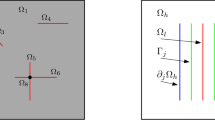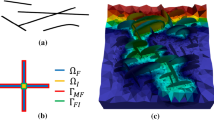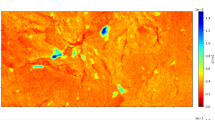Abstract
The diverse numerical simulation techniques employed to predict fluid flow properties of fractures yield differing results which limits their applicability for reactive transport simulations. Basically the fluid flow simulation techniques can be divided in two groups: (i) techniques that yield average fluid flow characteristics and (ii) techniques that produce space-resolved properties. These differences may have substantial impact on the reactive transport simulations but may also depend on the fracture characteristics. For this reason, a sensitivity analysis of the geometrical properties of fractures on the fluid flow properties is conducted and evaluated with respect to their impact on reactive transport modeling. Although employing space-resolved simulation techniques, the results of the tests show average values for permeability and fluid velocity that are comparable to previous studies that used other simulation techniques. Observed fluid flow channeling appears to be related to fracture surfaces matching and anisotropy. However, average flow velocities at potential sites for reactive transport differ up to a factor of five from the average ones for the entire fracture. Furthermore, extreme values at reactive transport sites may differ even more and the flow may be directed against the applied pressure gradient. For studies concerned with simulation of reactive transport, these deviations are crucial and should be explicitly considered in the calculations. Hence space-resolved fluid flow simulations should be employed for the simulation of reactive transport.















Similar content being viewed by others
References
Al-Omari, A., Masad, E.: Three dimensional simulation of fluid flow in X-ray CT images of porous media. Int. J. Numer. Anal. Methods Geomech. 28(13), 1327–1360 (2004)
Arns, C.H., Knackstedt, M.A., Pinczewski, W.V., Martys, N.S.: Virtual permeametry on microtomographic images. J. Petrol. Sci. Eng. 45(1–2), 41–46 (2004)
Berkowitz, B.: Characterizing flow and transport in fractured geological media: a review. Adv. Water Resour. 25(8–12), 861–884 (2002)
Brown, S.R.: Fluid flow through rock joints: the effect of surface roughness. J. Geophys. Res. 92(B2), 1337–1347 (1987)
Brown, S.R.: Transport of fluid and electric current through a single fracture. J. Geophys. Res. 94(B7), 9429–9438 (1989)
Brown, S.R.: Measuring the dimension of self-affine fractals: examples of rough surfaces. In: Barton, C.A., La Pointe, P.R. (eds.) Fractals in the Earth Sciences, pp. 77–87. Plenum Press, New York (1995a)
Brown, S.R.: Simple mathematical model of a rough fracture. J. Geophys. Res. 100(B4), 5941–5952 (1995b)
Brown, S.R., Scholz, C.H.: Broad bandwidth of the topography of nature rock surfaces. J. Geophys. Res. 90, 12575–12582 (1985)
Brown, S.R., Scholz, C.H.: Closure of rock joints. J. Geophys. Res. 91(B5), 4939–4948 (1986)
Brown, S.R., Stockman, H.W., Reeves, S.J.: Applicability of the Reynolds equation for modeling fluid flow between rough surfaces. Geophys. Res. Lett. 22(18), 2537–2540 (1995)
Bruderer-Weng, C., Cowie, P., Bernabé, Y., Main, I.: Relating flow channelling to tracer dispersion in heterogeneous networks. Adv. Water Resour. 27(8), 843–855 (2004)
Crandall, D., Bromhal, G., Karpyn, Z.T.: Numerical simulations examining the relationship between wall-roughness and fluid flow in rock fractures. Int. J. Rock Mech. Mining. Sci. 47, 784–796 (2010)
d’Humières, D., Ginzburg, I., Krafczyk, M., Lallemand, P., Luo, L.S.: Multiple-relaxation-time lattice Boltzmann models in three dimensions. Phil. Trans. R. Soc. Lond. A 360(1792), 437–451 (2002)
Dijk, P.E., Berkowitz, B.: Three-dimensional flow measurements in rock fractures. Water Resour. Res. 35(12), 3955–3959 (1999)
Eker, E., Akin, S.: Lattice boltzmann simulation of fluid flow in synthetic fractures. Transp. Porous Med. 65(3), 363–384 (2006)
Gadelmawla, E., Koura, M., Maksoud, T., Elewa, I., Soliman, H.: Roughness parameters. J. Mater. Process. Technol. 123(1), 133–145 (2002)
Ginzburg, I., d’Humieres, D.: Multireflection boundary conditions for lattice Boltzmann models. Phys. Rev. E 68(6), 30 (2003)
Ginzburg, I., Steiner, K.: Lattice Boltzmann model for free-surface flow and its application to filling process in casting. J. Comput. Phys. 185(1), 61–99 (2003)
Glover, P.W.J., Matsuki, K., Hikima, R., Hayashi, K.: Synthetic rough fractures in rocks. J. Geophys. Res. 103(B5), 9609–9620 (1998)
Hilgers, C., Dilg-Gruschinski, K., Urai, J.L.: Microstructural evolution of syntaxial veins formed by advective flow. Geology 32(3), 261–264 (2004)
Jessell, M.W., Cox, S.J.D., Schwarze, P., Power, W.L.: The anisotropy of surface roughness measured using a digital photogrammetric technique. In: Ameen, M.S. (ed.) Fractography: Fracture Topography as a Tool in Fracture Mechanics and Stress Analysis, vol. 92. Geological Society, London, Special Publications, vol. 1, pp. 27–37 (1995)
Kehrwald, D.: Parallel lattice Boltzmann simulation of complex flows. In: Berichte des Fraunhofer ITWM, vol. 61. p. 12. Kaiserslautern (2004)
Keller, A.A., Roberts, P.V., Blunt, M.J.: Effect of fracture aperture variations on the dispersion of contaminants. Water Resour. Res. 35(1), 55–63 (1999)
Ketcham, R.A., Carlson, W.D.: Acquisition, optimization and interpretation of X-ray computed tomographic imagery: applications to the geosciences. Comput. Geosci. 27, 381–400 (2001)
Khan, F., Enzmann, F., Kersten, M., Wiegmann, A., Steiner, K.: 3D simulation of the permeability tensor in a soil aggregate on basis of nanotomographic imaging and LBE solver. J. Soils Sedim 1–11 (2011)
Kim, I., Lindquist, W.B., Durham, W.B.: Fracture flow simulation using a finite-difference lattice Boltzmann method. Phys. Rev. E 67(4), 46708 (2003)
Kolditz, O.: Non-linear flow in fractured rock. Int. J. Numer. Methods Heat Fluid Flow 11(6), 547–575 (2001)
Lomize, G.M.: Flow in Fractured Rocks (in Russian). Gosenergoizdat, Moscow (1951)
Louis, C.: Strömungsvorgänge in klüftigen Medien und ihre Wirkung auf die Standsicherheit von Bauwerken und Böschungen im Fels. Technische Hochschule Karlsruhe (1967)
Maini, Y.N.: In Situ Hydraulic Parameters in Jointed Rock-Their Measurement and Interpretation. Imperial College of Science and Technology, London (1971)
Méheust, Y., Schmittbuhl, J.: Geometrical heterogeneities and permeability anisotropy of rough fractures. J. Geophys. Res. 106(B2), 2089–2102 (2001)
Méheust, Y., Schmittbuhl, J.: Scale effects related to flow in rough fractures. Pure Appl. Geophys. 160(5), 1023–1050 (2003)
Moreno, L., Tsang, C.F.: Flow channeling in strongly heterogeneous porous media: a numerical study. Water Resour. Res. 30(5), 1421–1430 (1994)
Mourzenko, V., Thovert, J.F., Adler, P.: Permeability of a single fracture; validity of the Reynolds equation. J. Phys. II 5(3), 465–482 (1995)
Narváez, A., Zauner, T., Raischel, F., Hilfer, R., Harting, J.: Quantitative analysis of numerical estimates for the permeability of porous media from lattice-Boltzmann simulations. arXiv 1005, 1.0 (2010)
Neretnieks, I., Eriksen, T., Tähtinen, P.: Tracer movement in a single fissure in granitic rock: some experimental results and their interpretation. Water Resour. Res. 18(4), 849–858 (1982)
Neuville, A., Toussaint, R., Schmittbuhl, J.: Hydrothermal coupling in a self-affine rough fracture. Phys. Rev. E 82(3), 036317 (2010)
Neuville, A., Toussaint, R., Schmittbuhl, J.: Hydraulic transmissivity and heat exchange efficiency of open fractures: a model based on lowpass filtered apertures. Geophys. J. Int. (2011)
Ogilvie, S.R., Isakov, E., Glover, P.W.J.: Fluid flow through rough fractures in rocks. II: a new matching model for rough rock fractures. Earth Planetary Sci. Lett. 241, 454–465 (2006)
Oron, A.P., Berkowitz, B.: Flow in rock fractures: the local cubic law assumption reexamined. Water Resour. Res. 34(11), 2811–2825 (1998)
Pan, C., Luo, L.S., Miller, C.T.: An evaluation of lattice Boltzmann schemes for porous medium flow simulation. Comput. Fluids 35(8–9), 898–909 (2006)
Plouraboué, F., Kurowski, P., Hulin, J.P., Roux, S., Schmittbuhl, J.: Aperture of rough cracks. Phys. Rev. E 51(3), 1675 (1995)
Prandtl, L., Oertel, H.: Führer durch die Strömungslehre, vol. 10. Auflage. Vieweg, Braunschweig (2001)
Pyrak-Nolte, L.J., Cook, N.G.W., Nolte, D.D.: Fluid percolation through single fractures. Geophys. Res. Lett. 15(11), 1247–1250 (1988)
Rasmuson, A., Neretnieks, I.: Radionuclide transport in fast channels in crystalline rock. Water Resour. Res. 22(8), 1247–1256 (1986)
Renshaw, C.E.: On the relationship between mechanical and hydraulic apertures in rough-walled fractures. J. Geophys. Res. 100, 24629–24636 (1995)
Romm, E.: Flow characteristics of fractured rocks (in Russian). Nedra, Moscow (1966)
Schmittbuhl, J., Gentier, S., Roux, S.: Field measurements of the roughness of fault surfaces. Geophys. Res. Lett. 20(8), 639–641 (1993)
Schmittbuhl, J., Steyer, A., Jouniaux, L., Toussaint, R.: Fracture morphology and viscous transport. Int. J. Rock Mech. Mining Sci. 45(3), 422–430 (2008)
Schulz, V., Kehrwald, D., Wiegmann, A., Steiner, K.: Flow, heat conductivity, and gas diffusion in partly saturated microstructures. In: Simulation of Complex Flows (CFD), Wiesbaden 2005. Fraunhofer ITWM Kaiserslautern
Snow, D.T.: A Parallel Plate Model of Permeable Fractured Media. Ph. D. Thesis, University of California, Berkeley, California (1965)
Sukop, M.C., Thorne, D.T.J.: Lattice Boltzmann Modeling. Springer, Heidelberg (2006)
Taylor, W.L., Pollard, D.D., Aydin, A.: Fluid flow in discrete joint sets: field observations and numerical simulations. J. Geophys. Res. 104(B12), 28,983–929,006 (1999)
Thömmes, G., Becker, J., Junk, M., Vaikuntam, A.K., Kehrwald, D., Klar, A., Steiner, K., Wiegmann, A.: A lattice Boltzmann method for immiscible multiphase flow simulations using the level set method. J. Comput. Phys. 228(4), 1139–1156 (2009)
Thömmes, G., Becker, J., Junk, M., Vaikuntam, A., Kehrwald, D., Klar, A., Steiner, K., Wiegmann, A.: Numerical investigation of a combined lattice Boltzmann-level set method for three-dimensional multiphase flow. Int. J. Comput. Fluid Dynam. 23(10), 687–697 (2010)
Tsang, C.F., Neretnieks, I.: Flow channeling in heterogeneous fractured rocks. Rev. Geophys. 36(2), 275–298 (1998)
van Genabeek, O., Rothman, D.H.: Critical behavior in flow through a rough-walled channel. Phys. Lett. A 255(1–2), 31–36 (1999)
Walsh, J.B., Brace, W.F.: The effect of pressure on porosity and the transport properties of rock. J. Geophys. Res. 89(B11), 9425–9431 (1984)
Wang, J.G., Leung, C.F., Chow, Y.K.: Numerical solutions for flow in porous media. Int. J. Numer. Anal. Methods Geomech. 27(7), 565–583 (2003)
Whitehouse, D.J., Archard, J.F.: The properties of random surfaces of significance in their contact. Proc. R. Soc. Lond A 316(1524), 97–121 (1970)
Wiegmann, A.: Computation of the permeability of porous materials from their microstructure by FFF-Stokes. In: Prätzel-Wolters, D. (ed.) Berichte des Fraunhofer ITWM, p. 24. ITWM, Kaiserslautern (2007)
Wildenschild, D., Vaz, C.M., Rivers, M.L., Rikard, D., Christensen, B.S.B.: Using X-ray computed tomography in hydrology: systems, resolutions, and limitations. J. Hydrol. 267(3–4), 285–297 (2002)
Witherspoon, P.A., Wang, J.S.Y., Iwai, K., Gale, J.E.: Validity of cubic law for fluid flow in a deformable rock fracture. Water Resour. Res. 16(6), 1016–1024 (1980)
Yang, C., Tartaglino, U., Persson, B.: Influence of surface roughness on superhydrophobicity. Phys. Rev. Lett. 97(11), 116103 (2006)
Zimmerman, R.W., Bodvarsson, G.S.: Hydraulic conductivity of rock fractures. Transp. Porous Med. 23(1), 1–30 (1996)
Acknowledgments
The authors acknowledge helpful reviews by two anonymous reviewers who made valuable suggestions to improve the manuscript. This study is carried out within the framework of DGMK (German Society for Petroleum and Coal Science and Technology) research project 718 “Mineral Vein Dynamics Modelling,” which is funded by the companies ExxonMobil Production Deutschland GmbH, GDF SUEZ E&P Deutschland GmbH, RWE Dea AG and Wintershall Holding GmbH, within the basic research program of the WEG Wirtschaftsverband Erdöl- und Erdgasgewinnung e.V. We thank the companies for their financial support and their permission to publish our results.
Author information
Authors and Affiliations
Corresponding author
Electronic supplementary material
Below is the link to the electronic supplementary material.
Rights and permissions
About this article
Cite this article
Schwarz, JO., Enzmann, F. Simulation of Fluid Flow on Fractures and Implications for Reactive Transport Simulations. Transp Porous Med 96, 501–525 (2013). https://doi.org/10.1007/s11242-012-0103-0
Received:
Accepted:
Published:
Issue Date:
DOI: https://doi.org/10.1007/s11242-012-0103-0




